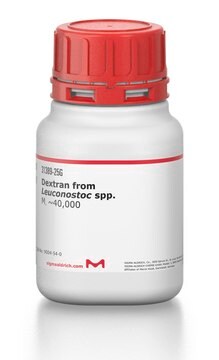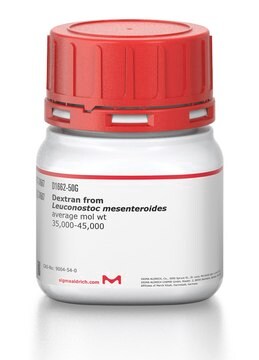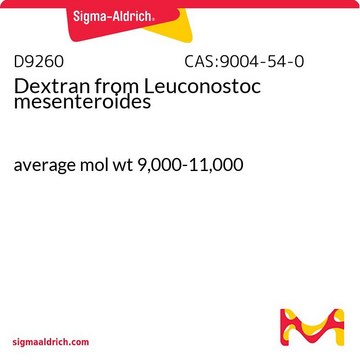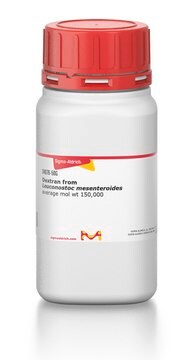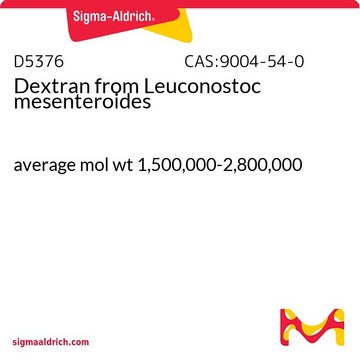D4626
Dextrane from Leuconostoc mesenteroides
average mol wt 15,000-30,000
About This Item
Produits recommandés
Source biologique
bacterial (Leuconostoc mesenteroides)
Niveau de qualité
Forme
powder
Activité optique
[α]/D 199°
Poids mol.
average mol wt 15,000-30,000
Couleur
white
Solubilité
water: 20 mg/mL, clear, colorless to faintly yellow
InChI
1S/C18H32O16/c19-1-5(21)9(23)10(24)6(22)3-31-17-16(30)14(28)12(26)8(34-17)4-32-18-15(29)13(27)11(25)7(2-20)33-18/h1,5-18,20-30H,2-4H2
Clé InChI
FZWBNHMXJMCXLU-UHFFFAOYSA-N
Vous recherchez des produits similaires ? Visite Guide de comparaison des produits
Description générale
Application
Notes préparatoires
Autres remarques
Code de la classe de stockage
11 - Combustible Solids
Classe de danger pour l'eau (WGK)
WGK 2
Point d'éclair (°F)
Not applicable
Point d'éclair (°C)
Not applicable
Équipement de protection individuelle
Eyeshields, Gloves, type N95 (US)
Certificats d'analyse (COA)
Recherchez un Certificats d'analyse (COA) en saisissant le numéro de lot du produit. Les numéros de lot figurent sur l'étiquette du produit après les mots "Lot" ou "Batch".
Déjà en possession de ce produit ?
Retrouvez la documentation relative aux produits que vous avez récemment achetés dans la Bibliothèque de documents.
Les clients ont également consulté
Articles
Dmitri Simberg (University of Colorado Anschutz Medical Campus, USA) reviews the used of dextran and cyclodextrin for the synthesis of nanoparticles used in drug delivery applications.
Dmitri Simberg (University of Colorado Anschutz Medical Campus, USA) reviews the used of dextran and cyclodextrin for the synthesis of nanoparticles used in drug delivery applications.
Protocoles
Dextran is a polymer of anhydroglucose. It is composed of approximately 95% alpha-D-(1-6) linkages. The remaining a(1-3) linkages account for the branching of dextran. Conflicting data on the branch lengths implies that the average branch length is less than three glucose units. However, other methods indicate branches of greater than 50 glucose units exist.
Notre équipe de scientifiques dispose d'une expérience dans tous les secteurs de la recherche, notamment en sciences de la vie, science des matériaux, synthèse chimique, chromatographie, analyse et dans de nombreux autres domaines..
Contacter notre Service technique